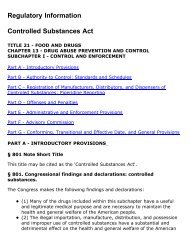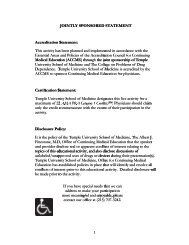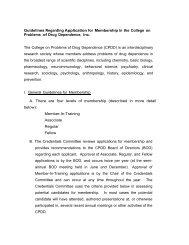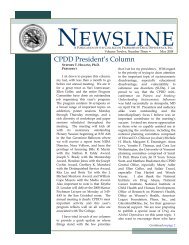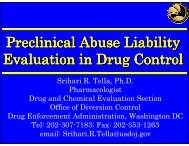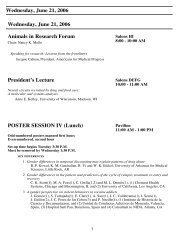CPDD 72nd Annual Meeting • Scottsdale, Arizona - The College on ...
CPDD 72nd Annual Meeting • Scottsdale, Arizona - The College on ...
CPDD 72nd Annual Meeting • Scottsdale, Arizona - The College on ...
Create successful ePaper yourself
Turn your PDF publications into a flip-book with our unique Google optimized e-Paper software.
133<br />
URB597, A FATTY ACID AMIDE HYDROLASE METABOLISM<br />
INHIBITOR, EFFECTS LOCOMOTOR ACTIVITY<br />
IMMEDIATELY AFTER THE FORCED SWIM TEST.<br />
Tyechia Culmer 1 , L A Dykstra 1,2 ; 1 Pharmacology, University of North Carolina<br />
at Chapel Hill, Chapel Hill, NC, 2 Psychology, University of North Carolina at<br />
Chapel Hill, Chapel Hill, NC<br />
Aims: <str<strong>on</strong>g>The</str<strong>on</strong>g> effects of CB1 receptor activati<strong>on</strong> in the forced swim test (FST) and<br />
<strong>on</strong> locomotor activity (LMA) were examined by manipulating the endogenous<br />
receptor ag<strong>on</strong>ist anandamide with URB597. URB597 inhibits the enzymatic<br />
activity of fatty acid amide hydrolase (FAAH) and thereby increases the c<strong>on</strong>centrati<strong>on</strong><br />
of anandamide and activates the CB1 receptor.<br />
Methods: C57Bl/6 mice (n=9-10) were exposed to the FST (6 min in 25° C<br />
water) following an intraperit<strong>on</strong>eal (i.p.) injecti<strong>on</strong> of vehicle or a dose of 0.03<br />
mg/kg or 0.1 mg/kg URB597. Immediately after the FST, the mice were placed<br />
in a locomotor activity chamber (30 min; LAC). <str<strong>on</strong>g>The</str<strong>on</strong>g> effect of CB1 receptor activati<strong>on</strong><br />
and FST exposure was measured by time spent immobile (sec) in the FST<br />
and by distance traveled (cm), the average velocity (cm/sec), total entries into the<br />
center z<strong>on</strong>e (#), and total time spent in the center z<strong>on</strong>e (sec) in the LAC. LMA<br />
was measured before the FST (Pre-FST1), immediately after the FST (Post-<br />
FST1), and a week after the FST (LMA-FST1).<br />
Results: Time spent immobile in the FST was similar in C57Bl/6 mice treated<br />
with vehicle and URB597 at doses 0.03 mg/kg and 0.1 mg/kg. LMA was<br />
reduced significantly during the Post-FST1 sessi<strong>on</strong> compared to LMA during the<br />
Pre-FST1. Also, a significant increase in the total time spent in the center (0-10<br />
min) was observed in mice treated with 0.03 mg/kg URB597 compared to vehicle<br />
in both the Post-FST1 and LMA-FST1. In additi<strong>on</strong>, the average velocity<br />
increased significantly in mice treated with 0.03 mg/kg URB597 compared to<br />
vehicle in the Post-FST1 (20-30 min).<br />
C<strong>on</strong>clusi<strong>on</strong>s: <str<strong>on</strong>g>The</str<strong>on</strong>g>se data suggest an interacti<strong>on</strong> between CB1 receptor activati<strong>on</strong><br />
and resp<strong>on</strong>ses in the FST and LAC. Under these c<strong>on</strong>diti<strong>on</strong>s, URB597 did not<br />
decrease time spent immobile in the FST as reported with antidepressants such<br />
as desipramine (Lucki, 2001). However, a low dose of URB597 increased time<br />
in the center immediately after the FST in the LAC.<br />
Financial Support: Provided by NIH grants R01-DA002749 and T32-007244.<br />
135<br />
DOPAMINE β HYDROXYLASE INHIBITOR SYN117<br />
DECREASES SUBJECTIVE EFFECTS OF COCAINE.<br />
K A Cunningham 1 , C L Carb<strong>on</strong>e 1 , N C Anastasio 1 , T A Harper 1 , F G Moeller 2 ,<br />
D L Ware 1 , M A Fuller 1 , G J Holstein 1 , K E Smith 1 , J B Jayroe 1 , S Bandak 3 , K<br />
Reiman 3 , A Neale 3 , L Pickford 3 ; 1 Center for Addicti<strong>on</strong> Research, Univ Texas<br />
Med Branch, Galvest<strong>on</strong>, TX, 2 Psychiatry Behav Sci, Univ Texas HSC, Houst<strong>on</strong>,<br />
TX, 3 Synosia <str<strong>on</strong>g>The</str<strong>on</strong>g>rapeutics, Inc., San Francisco, CA<br />
Aims: <str<strong>on</strong>g>The</str<strong>on</strong>g> n<strong>on</strong>-selective DβH inhibitor disulfiram blocks the subjective effects of<br />
cocaine and reduces its use. We tested the hypothesis that the selective DβH<br />
inhibitor SYN117 will reduce the positive subjective effects of cocaine in a doubleblind,<br />
placebo-c<strong>on</strong>trolled, inpatient study with fewer side effects than disulfiram.<br />
Methods: N<strong>on</strong>-treatment seeking, cocaine dependent subjects were randomized<br />
to placebo (n=5) or placebo/80 mg/160 mg of SYN117 for 13 days (n=15). <str<strong>on</strong>g>The</str<strong>on</strong>g><br />
pharmacokinetics of cocaine and its cardiovascular and subjective effects were<br />
measured at ascending doses of 0, 10, 20 and 40 mg of intravenous cocaine in<br />
subjects treated with placebo or SYN117.<br />
Results: SYN117 was well-tolerated and there was no difference in adverse<br />
events observed after the combinati<strong>on</strong> of SYN117 and cocaine vs. cocaine al<strong>on</strong>e.<br />
<str<strong>on</strong>g>The</str<strong>on</strong>g> pharmacokinetics of cocaine was unaltered. A main effect of SYN117,<br />
cocaine and an interacti<strong>on</strong> were observed (ANOVA) for some measures <strong>on</strong> the<br />
Visual Analogue Scale (VAS). ‘Drug effect,’ ‘high,’ ‘good effects,’ and ‘stimulated’<br />
significantly decreased in subjects receiving SYN117 plus cocaine vs. placebo<br />
plus cocaine. SYN117 significantly increased ratings of ‘depressed’ and ‘anxious’.<br />
‘Craving’ did not change.<br />
C<strong>on</strong>clusi<strong>on</strong>s: <str<strong>on</strong>g>The</str<strong>on</strong>g>se data show that SYN117 significantly alters the subjective<br />
effects of cocaine and is well tolerated by human subjects. In comparis<strong>on</strong> to<br />
disulfiram which resulted in increased levels of plasma cocaine and decreased<br />
cocaine clearance, SYN117 did not alter the pharmacokinetics of cocaine in<br />
keeping the selectivity of SYN117 as a DβH inhibitor. Thus, the present phase<br />
I analysis suggests that further examinati<strong>on</strong> of SYN117 for efficacy in treatment<br />
of cocaine dependent subjects is warranted.<br />
Financial Support: Synosia <str<strong>on</strong>g>The</str<strong>on</strong>g>rapeutics, Inc., UTMB Center for Addicti<strong>on</strong><br />
Research, UTMB Clinical Research Center, DA009262, DA024157,<br />
DA020087<br />
<str<strong>on</strong>g>CPDD</str<strong>on</strong>g> <str<strong>on</strong>g>72nd</str<strong>on</strong>g> <str<strong>on</strong>g>Annual</str<strong>on</strong>g> <str<strong>on</strong>g>Meeting</str<strong>on</strong>g> <str<strong>on</strong>g>•</str<strong>on</strong>g> <str<strong>on</strong>g>Scottsdale</str<strong>on</strong>g>, <str<strong>on</strong>g>Ariz<strong>on</strong>a</str<strong>on</strong>g><br />
34<br />
134<br />
MECHANISMS OF PRESCRIPTION DRUG DIVERSION<br />
AMONG IMPAIRED PHYSICIANS.<br />
Sim<strong>on</strong>e M Cummings, L J Merlo, L B Cottler; Psychiatry, Washingt<strong>on</strong><br />
University School of Medicine, St. Louis, MO<br />
Aims: To investigate mechanisms of prescripti<strong>on</strong> drug diversi<strong>on</strong> am<strong>on</strong>g a populati<strong>on</strong><br />
of physicians being m<strong>on</strong>itored for substance abuse and to explore policy<br />
opti<strong>on</strong>s for preventing the specific methods of diversi<strong>on</strong> uncovered. <str<strong>on</strong>g>The</str<strong>on</strong>g> authors<br />
hypothesize that methods of diversi<strong>on</strong> used by physicians are a functi<strong>on</strong> of the<br />
access to prescripti<strong>on</strong> drugs that they have by virtue of their professi<strong>on</strong>.<br />
Methods: A qualitative study using focus groups was c<strong>on</strong>ducted to gather informati<strong>on</strong><br />
about prescripti<strong>on</strong> drug diversi<strong>on</strong> am<strong>on</strong>g impaired physicians being<br />
m<strong>on</strong>itored by a state physician health program (PHP). N<strong>on</strong>-probabilistic, purposive<br />
sampling was used to obtain a geographically diverse group of physician<br />
participants. PHP m<strong>on</strong>itors arranged the focus group sessi<strong>on</strong>s and recruited all<br />
participants. Nine focus groups, which included a total of 54 physicians, were<br />
c<strong>on</strong>ducted. Focus groups were an<strong>on</strong>ymous. Physicians were not compensated for<br />
participati<strong>on</strong>. Audiotapes of the focus group sessi<strong>on</strong>s were transcribed and loaded<br />
into Atlas.ti for coding and analysis.<br />
Results: Physicians reported using five primary methods to divert prescripti<strong>on</strong><br />
drugs: stealing from patients; stealing from health care organizati<strong>on</strong>s; utilizing<br />
samples provided by prescripti<strong>on</strong> drug reps; ordering large shipments of drugs<br />
from pharmaceutical warehouses for pers<strong>on</strong>al use; and self-prescribing or prescribing<br />
in the name of patients and/or friends for pers<strong>on</strong>al use. <str<strong>on</strong>g>The</str<strong>on</strong>g> most comm<strong>on</strong>ly<br />
diverted drugs included prescripti<strong>on</strong> opioids, followed by prescripti<strong>on</strong><br />
sedatives. Many physicians reported diverting for several years before being<br />
caught.<br />
C<strong>on</strong>clusi<strong>on</strong>s: Mechanisms of prescripti<strong>on</strong> drug diversi<strong>on</strong> used by physicians<br />
result from their increased access to prescripti<strong>on</strong> drugs relative to the general<br />
populati<strong>on</strong>. <str<strong>on</strong>g>The</str<strong>on</strong>g> development of policies to require funding of state prescripti<strong>on</strong><br />
drug m<strong>on</strong>itoring programs as well as policies to restrict the distributi<strong>on</strong> of drug<br />
samples has the potential to mitigate the amount of prescripti<strong>on</strong> drug diversi<strong>on</strong><br />
that occurs am<strong>on</strong>g physicians as well as other health care pers<strong>on</strong>nel.<br />
Financial Support: This work was supported by a NIDA Diversity Supplement<br />
to R01DA020791, LB Cottler, PI.<br />
136<br />
DIFFERENTIAL ANTAGONISM OF THE BEHAVIORAL<br />
EFFECTS OF NICOTINE, VARENICLINE, AND CYTISINE<br />
IN MICE.<br />
Colin S Cunningham, L R McMah<strong>on</strong>; Pharmacology, UTHSCSA, San<br />
Ant<strong>on</strong>io, TX<br />
Aims: Although nicotine replacement therapy is effective in promoting abstinence<br />
from cigarette smoking, there is margin for improvement. Varenicline is<br />
reported to be more effective than nicotine replacement therapy and comparatively<br />
less is known about cytisine, a pharmacotherapy for tobacco dependence<br />
in Europe. To examine the possibility that nicotine acetylcholine receptor subtypes<br />
differentially mediate behavioral effects, nicotine, varenicline, and cytisine<br />
were combined with antag<strong>on</strong>ists differing in their selectivity for receptors c<strong>on</strong>taining<br />
α4β2 subunits.<br />
Methods: Male C57BL/6J mice (n=7) resp<strong>on</strong>ding <strong>on</strong> a fixed ratio 30 schedule<br />
of food delivery received i.p. nicotine, varenicline, and cytisine, al<strong>on</strong>e and in<br />
combinati<strong>on</strong> with the n<strong>on</strong>-selective nicotine antag<strong>on</strong>ist mecamylamine and the<br />
α4β2 nicotine receptor-selective antag<strong>on</strong>ist dihydro-β-erythroidine (DHβE).<br />
Results: Nicotine, varenicline, and cytisine dose-dependently decreased resp<strong>on</strong>ding;<br />
nicotine was more potent (ED50 = 0.72 mg/kg) than varenicline (ED50 =<br />
1.8 mg/kg) and cytisine (ED50 = 2.7 mg/kg). <str<strong>on</strong>g>The</str<strong>on</strong>g> ag<strong>on</strong>ists had a similar time<br />
course of activity, including a rapid <strong>on</strong>set (



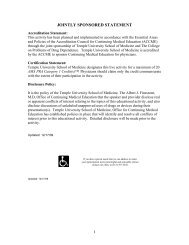
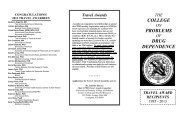
![2013SYMP AND WORKSHOP LIST[web]](https://img.yumpu.com/35325424/1/190x245/2013symp-and-workshop-listweb.jpg?quality=85)
